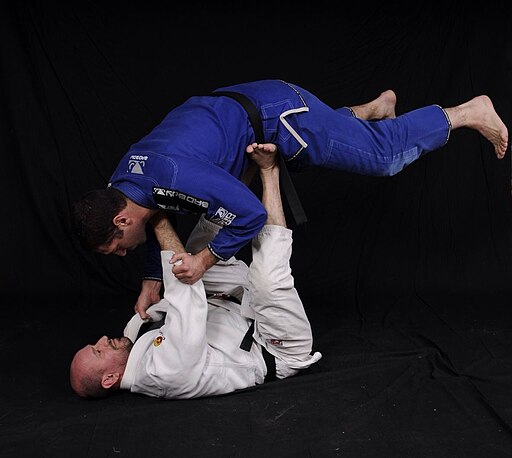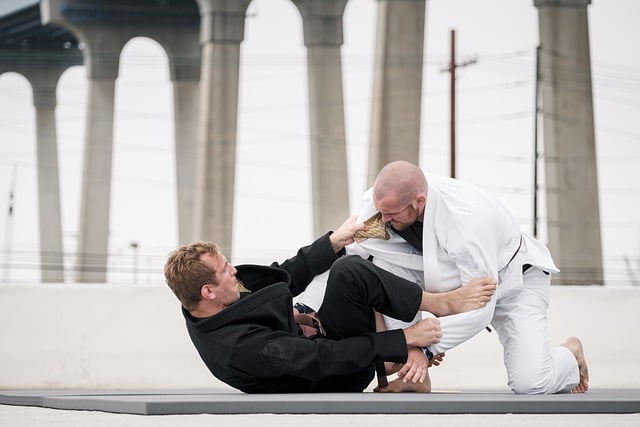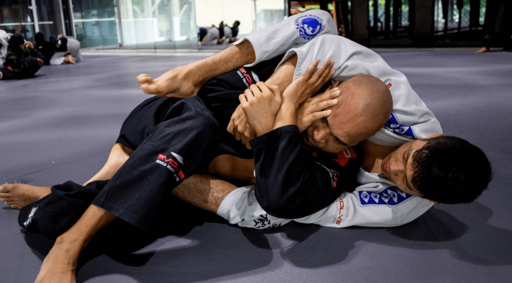BJJ (Brazilian Jiu-Jitsu) is a specific style of Jiu-Jitsu with a focus on ground fighting and submissions, whereas Jiu-Jitsu encompasses various traditional Japanese martial arts techniques.
TL;DR Bjj Vs. Jiu Jitsu
BJJ, originally developed in Brazil, has its roots in Jiu Jitsu. It can be traced back to Mitsuyo Maeda, a Japanese judoka, who introduced the art to Brazil in the early 20th century.
BJJ emphasizes ground fighting and submission holds, with a focus on using leverage and technique to overcome larger opponents.
It has gained recognition in the martial arts world, particularly through the Gracie family, who have popularized its effectiveness in mixed martial arts (MMA) competitions.
Jiu Jitsu, also known as Japanese Jiu Jitsu, is a traditional Japanese martial art that originated centuries ago. It encompasses a broader range of techniques, including strikes, joint locks, throws, and groundwork. Jiu Jitsu places less emphasis on sport and competition, focusing more on self-defense and personal development.
What is BJJ?

BJJ, or Brazilian Jiu Jitsu, is a fascinating martial art that has gained immense popularity in recent years. In this section, we’ll dive into the world of BJJ, exploring its origins, philosophy, principles, and techniques. Get ready to discover the rich history behind this captivating form of combat, uncover the core values that guide practitioners, and explore the technical aspects of training in BJJ. Whether you’re a seasoned practitioner or a curious beginner, this section will provide valuable insights into the captivating world of BJJ.
Origins of BJJ
The origins of BJJ can be traced back to the early 20th century in Brazil. It was developed by the Gracie family, specifically Carlos Gracie and his younger brother Helio Gracie.[1] They were influenced by their training in Kodokan Judo and adapted the techniques to suit their smaller frames. BJJ is known for its emphasis on ground fighting and submissions, making it a highly effective martial art for self-defense and competition.
The Gracie family began teaching BJJ in Brazil, and it quickly gained popularity for its effectiveness in real-life combat situations. As more people learned about the benefits of BJJ, it started to spread beyond Brazil’s borders. In the 1990s, BJJ gained global recognition when the Gracie family, specifically Royce Gracie, showcased its effectiveness in the early Ultimate Fighting Championship (UFC) events.
Today, BJJ is practiced all around the world, with millions of practitioners of all ages and skill levels. It has become an essential component of mixed martial arts (MMA) training and is widely regarded as one of the most effective martial arts for self-defense and competition.
Philosophy and Principles of BJJ
The philosophy and principles of BJJ revolve around the leverage, technique, and efficiency. The leveraging aspect emphasizes the use of leverage to overcome physical strength, allowing practitioners to control and submit their opponent regardless of size or strength.
Technique plays a crucial role, as BJJ practitioners constantly refine their techniques to make them as efficient as possible. They strive to execute techniques with precision and effectiveness to maximize success in combat.
Efficiency is another key principle, focusing on utilizing the most efficient movements and strategies to conserve energy and make the best use of one’s physical abilities. By working smarter, not harder, practitioners choose techniques and strategies that yield optimal results with minimal effort.
Furthermore, BJJ encourages problem-solving, requiring practitioners to think critically and find solutions to various scenarios and positions. Alongside these principles, respect and humility are promoted in BJJ philosophy.
Practitioners approach training with an open mind, willing to learn from others and acknowledge their own limitations.
This fosters a supportive, collaborative environment where everyone can grow and improve together. By embracing these principles, practitioners of BJJ cultivate physical prowess, mental resilience, and a deeper understanding of martial arts.
Techniques and Training in BJJ
In Brazilian Jiu Jitsu (BJJ), techniques and training are the vital components of this martial art. Practitioners actively participate in various exercises and drills to polish their skills and enhance their expertise.
The BJJ training sessions incorporate a mix of physical conditioning, learning and practicing techniques, as well as engaging in live sparring. These activities help develop both the physical and mental attributes necessary for success in BJJ.
During the training, practitioners actively engage in repeating drilling techniques to enhance muscle memory and refine their execution. They focus on fundamental techniques such as sweeps, submissions, and positional control.
Sparring, known as rolling in BJJ, is an integral part of the training. It enables practitioners to apply the techniques they have learned in a dynamic and live situation against opponents who resist. This process aids in the development of timing, reflexes, and decision-making abilities.
In BJJ training, there are also specific exercises designed to simulate realistic scenarios. These include situational drills where practitioners start in specific positions or with specific objectives, such as escaping from bottom mount or submitting an opponent.
Strength and conditioning training play a crucial role in BJJ. It encompasses exercises aimed at improving overall strength, endurance, flexibility, and mobility. Establishing a strong physical foundation is essential for executing techniques effectively and preventing injuries.
The techniques and training in BJJ are comprehensive and multifaceted. Practitioners dedicate themselves to refining their skills through repetitive drilling, engaging in live sparring, and participating in specific training exercises. This holistic approach allows them to cultivate proficiency and adaptability in the art of Brazilian Jiu Jitsu.
What is Jiu Jitsu?

Jiu Jitsu, a captivating martial art with deep-rooted traditions, embodies a world of physical prowess and strategic intellect. Dive into the essence of Jiu Jitsu as we explore its origins, delve into its philosophy and principles, and uncover the intricacies of its techniques and training. Discover the rich history and profound wisdom that underlie this ancient discipline, and brace yourself for a journey of self-discovery, mental fortitude, and unparalleled physical skill. Get ready to unlock the secrets of Jiu Jitsu and unleash your inner warrior.
Origins of Jiu Jitsu
The origins of Jiu Jitsu, also known as Jujutsu, can be traced back to ancient Japan. This martial art was originally developed by samurai warriors as a means of close combat and self-defense. It focused on utilizing leverage, joint locks, and throws to defeat opponents with minimal effort.
In Brazil, the Gracie family played a significant role in adapting and refining Jiu Jitsu, transforming it into Brazilian Jiu Jitsu (BJJ). They emphasized the importance of ground fighting and created techniques to neutralize adversaries who were larger and stronger. Mitsuyo Maeda, a Japanese Jiu Jitsu master who migrated to Brazil, greatly influenced this evolution.
Through challenge matches and competitions, the techniques of Jiu Jitsu were constantly tested and enhanced. The effectiveness of Jiu Jitsu in no-holds-barred matches, famously known as Vale Tudo, was showcased by the Gracies, particularly Helio Gracie. This contributed to the recognition of BJJ as one of the most effective martial arts for self-defense and combat sports.
Currently, Jiu Jitsu is practiced worldwide, with a focus on self-defense and sport. It promotes discipline, physical fitness, and mental resilience. Training in Jiu Jitsu develops a profound understanding of body mechanics and leverage, enabling practitioners to overcome opponents who possess superior size and strength.
Fact: Brazilian Jiu Jitsu gained significant popularity in the 1990s when Royce Gracie demonstrated its effectiveness by winning multiple matches in the early Ultimate Fighting Championship (UFC) events.
Philosophy and Principles of Jiu Jitsu
The philosophy and principles of Jiu Jitsu are at the core of this martial art. They revolve around the concept of using technique and leverage to overcome physical strength, enabling a smaller and weaker individual to successfully defend themselves against a larger and stronger opponent. By emphasizing proper technique and leverage, Jiu Jitsu promotes the idea that anyone can prevail in a confrontation.
Moreover, the philosophy of Jiu Jitsu emphasizes continuous improvement and personal growth. It encourages practitioners to constantly seek knowledge and refine their skills, aiming to become better martial artists. Discipline, respect, and humility are crucial aspects both on and off the mat, highlighting the importance of character development.
The principles of Jiu Jitsu center around positional dominance and control. Through various positions and submissions, practitioners learn how to gain and maintain control over opponents. The principle of control is fundamental in Jiu Jitsu as it enables practitioners to neutralize attacks and dictate the outcome of confrontations.
Another key aspect of Jiu Jitsu is patience and timing. Practitioners are taught to be patient, awaiting the opportune moment to execute techniques and submissions. Timing plays a critical role in Jiu Jitsu since the effectiveness of a technique depends greatly on its precise application.
Overall, the philosophy and principles of Jiu Jitsu foster self-defense, physical fitness, mental well-being, and personal development. This martial art cultivates not only physical prowess but also mental and emotional resilience.
Techniques and Training in Jiu Jitsu
When it comes to techniques and training in Jiu Jitsu, there are several key aspects to consider: fundamental techniques, drilling, live sparring, and competition training.
- Fundamental techniques: Beginners in Jiu Jitsu focus on learning basic techniques such as escapes, sweeps, and submissions. These foundational moves lay the groundwork for more advanced techniques.
- Drilling: Regular drilling is essential in Jiu Jitsu to develop muscle memory and improve technique execution. Practicing techniques repeatedly helps to build reflexes and increase proficiency.
- Live sparring: Live sparring, also known as rolling, is a crucial part of Jiu Jitsu training. It involves applying techniques in a simulated grappling scenario against a resisting opponent. This allows practitioners to test their skills, improve timing, and develop strategy.
- Competition training: For those interested in competing, specific training sessions are dedicated to preparing for tournaments. These sessions focus on conditioning, strategy, and refining techniques for the competitive environment.
A pro-tip for Jiu Jitsu training is to maintain consistency and patience. Progress in Jiu Jitsu takes time, and consistent training is key to improvement. It’s important to listen to your body and prioritize injury prevention by using proper technique and knowing when to rest.
Key Differences Between BJJ and Jiu Jitsu
Gi vs No-Gi
When comparing Gi vs No-Gi in Brazilian Jiu Jitsu (BJJ), there are some key differences to consider:
- Attire: In Gi BJJ, competitors wear a traditional uniform consisting of a jacket and pants made of thick, durable cotton. No-Gi BJJ is practiced with just shorts and a rash guard or tight-fitting shirt.
- Grip and Control: The presence of the gi in Gi BJJ allows for various grips and controls, such as collar chokes and sleeve grips. No-Gi BJJ relies more on body control and underhooks since there is no fabric to hold onto.
- Techniques: Gi BJJ often involves complex and intricate techniques that utilize the collar, lapel, or fabric grips. No-Gi BJJ emphasizes faster-paced and more explosive techniques that rely on body movement and positioning.
- Mobility: Without the restrictions of a gi, practitioners in No-Gi BJJ have greater freedom of movement and can rely more on athleticism and speed. Gi BJJ often requires developing a broader range of techniques to offset the limitations of the gi.
- Tournaments: Both Gi and No-Gi BJJ have their own separate tournaments and competitions. Some practitioners choose to specialize in one or the other, while others compete in both.
The choice between Gi and No-Gi in BJJ depends on personal preference, training goals, and the desire to experience different aspects of the sport. Whether a practitioner chooses to focus on one or engage in both, it ultimately enhances their overall development in Brazilian Jiu Jitsu.
Rules and Competitions
When it comes to rules and competitions in BJJ and Jiu Jitsu, there are some key differences to consider. Here is a comparison between the two martial arts:
| BJJ | Jiu Jitsu |
|---|---|
| BJJ competitions are commonly known as tournaments and are organized by various governing bodies, such as the International Brazilian Jiu Jitsu Federation (IBJJF). | Jiu Jitsu competitions can vary depending on the specific style or organization, but they are generally less formal than BJJ tournaments. |
| BJJ competitions have specific weight divisions and belt levels to ensure fair matchups. | Jiu Jitsu competitions may have weight divisions, but they often focus more on open weight or absolute divisions where competitors of any weight can compete against each other. |
| BJJ competitions allow various techniques, including joint locks, chokes, and sweeps, both on the ground and standing. | Jiu Jitsu competitions may have specific rules depending on the style or organization, but they generally allow a wider range of techniques compared to BJJ, including strikes and takedowns. |
| BJJ tournaments usually follow a gi (kimono) or no-gi format, with competitors either wearing the traditional gi or using specialized no-gi attire. | Jiu Jitsu competitions can also have gi or no-gi divisions, but they are more open to different attire options, including the use of traditional uniforms or casual clothing. |
It’s important to familiarize yourself with the specific rules and regulations of any competition you plan to participate in, as they may vary between different tournaments and organizations.
Fun Fact: The first BJJ competition was held in 1976 in Teresópolis, Brazil, and it paved the way for the growth and popularity of the sport worldwide.
Sports vs Traditional Approach
The table below highlights the key differences between the Sports Approach and the Traditional Approach in Brazilian Jiu Jitsu (BJJ) and Jiu Jitsu:
| Sports Approach | Traditional Approach | |
|---|---|---|
| Focus | Competition and athleticism | Self-defense and discipline |
| Techniques | Emphasis on high-percentage techniques | Broad range of techniques |
| Training | Drill specific moves and strategies | Emphasize positional training and live sparring |
| Gi vs No-Gi | Compete in both gi and no-gi competitions | Focus primarily on gi training |
| Rules | Follow tournament rules | Less restrictive rules, focus on self-defense scenarios |
| Mindset | Tactical and strategic thinking | Traditional values and philosophies |
| Training partners | Various sizes, skill levels | Train with a limited group of partners |
| Training intensity | High-intensity, fast-paced training | Slower pace, focus on detail |
| Application | Primarily for sport and competition | Practical application for real-life self-defense |
In the Sports Approach, the focus is on competition and athleticism. Techniques are often limited to high-percentage moves that are more likely to succeed in tournaments. Training drills specific moves and strategies to prepare for competitions, and there is a significant emphasis on gi training. The mindset is tactical and strategic.
On the other hand, the Traditional Approach prioritizes self-defense and discipline. A broad range of techniques is taught to prepare practitioners for different situations. Training involves positional training and live sparring, with less focus on competition. The rules are often less restrictive, allowing for more practical self-defense scenarios. The mindset is rooted in traditional values and philosophies.
It’s important to note that these approaches are not mutually exclusive, and many practitioners incorporate elements from both. The choice between the Sports and Traditional Approach depends on individual preferences and goals.
Focus on Ground Game
BJJ and Jiu Jitsu both have a strong focus on the ground game, with techniques and strategies that are specifically designed for grappling and submission holds. This aspect of the martial arts is crucial for success in both disciplines. In BJJ, practitioners train extensively in groundwork, learning various positions such as the guard, mount, and side control, and developing skills to control and submit their opponents. The ground game in Jiu Jitsu involves similar techniques and positions, with an emphasis on leverage, joint locks, and chokes.
The focus on the ground game in BJJ and Jiu Jitsu allows practitioners to effectively neutralize an opponent’s strength and size advantage by using leverage and technique. This aspect of the martial arts is especially important for self-defense, as many real-life altercations end up on the ground.
In BJJ, there is also a competitive aspect to the ground game, with tournaments and competitions that test a practitioner’s skill in applying techniques and securing submissions. It is important for BJJ practitioners to continually practice and refine their ground game to stay competitive.
The focus on the ground game in both BJJ and Jiu Jitsu is essential for mastering the martial arts. It provides practitioners with the ability to control and submit opponents, making it a fundamental aspect of their training and technique.
For those interested in improving their ground game, consistent training and practice are essential. It is also beneficial to study and learn from experienced practitioners and instructors who can provide guidance and feedback. By focusing on the ground game, practitioners can enhance their proficiency and effectiveness in BJJ and Jiu Jitsu.
Is There an Overlap Between BJJ and Jiu Jitsu?
Yes, there is an overlap between BJJ (Brazilian Jiu-Jitsu) and Jiu Jitsu. In fact, BJJ is a specific style or subset of Jiu Jitsu.
Here are a few points that highlight the overlap between BJJ and Jiu Jitsu:
- Origin: Both BJJ and Jiu Jitsu trace their roots back to ancient Japanese martial arts. Jiu Jitsu, also known as “traditional” or “Japanese” Jiu Jitsu, has a long history in Japan. BJJ, on the other hand, evolved from Jiu Jitsu when it was introduced to Brazil and modified by the Gracie family.
- Ground-Focused Grappling: Both BJJ and Jiu Jitsu emphasize ground-focused grappling techniques, such as joint locks, chokes, and submissions. They share many fundamental techniques and principles in this aspect.
- Submission-Based Fighting: BJJ and Jiu Jitsu prioritize submissions as a means to defeat an opponent. The goal is to gain control over an opponent and force them to submit through joint manipulation or chokes.
- Belt System: Both BJJ and Jiu Jitsu use a belt ranking system to signify a practitioner’s progression and skill level. The belt colors generally follow a similar progression, starting with white and progressing to black.
- Training Methods: The training methods in BJJ and Jiu Jitsu often involve live sparring, known as “rolling,” to practice and apply techniques in a realistic setting. This hands-on approach is an essential component of both styles.
While there is an overlap between BJJ and Jiu Jitsu, it’s important to note that BJJ has evolved into a distinct style with its own techniques, strategies, and ruleset. BJJ places a particular emphasis on ground fighting and has become widely recognized as a competitive martial art and combat sport.
| What's the Difference Between BJJ and Jiu-Jitsu |
|---|
| Brazilian Jiu-Jitsu (BJJ) and Japanese Jiu-Jitsu are two distinct martial arts with significant differences in technique and approach. (Source: Our Team) |
| BJJ emphasizes ground fighting and submission grappling, while Japanese Jiu-Jitsu focuses on throwing opponents and joint manipulation. (Source: Our Team) |
| BJJ does not involve striking techniques and primarily focuses on leveraging and controlling opponents to force submission. (Source: Our Team) |
| Japanese Jiu-Jitsu incorporates strikes, as well as techniques for self-defense such as choking, strangling, and blocking. (Source: Our Team) |
| BJJ has a well-defined belt system and is more competition-oriented, while Japanese Jiu-Jitsu offers self-defense techniques and may not have a standardized belt system. (Source: Our Team) |
Frequently Asked Questions
What’s the difference between Brazilian jiu-jitsu (BJJ) and Japanese jujutsu?
Brazilian jiu-jitsu (BJJ) and Japanese jujutsu may share a common origin, but they have distinct differences in terms of techniques and focus.
How does BJJ differ from Japanese jujutsu in terms of techniques?
BJJ primarily focuses on ground fighting and submission grappling, utilizing moves like guard passes, back control, knee-on-belly positions, and sweeps. On the other hand, Japanese jujutsu emphasizes throwing opponents, joint manipulation, striking techniques, and blocking.
What are the key factors that differentiate BJJ from Japanese jujutsu?
The main differentiating factors include BJJ’s emphasis on ground fighting and submission grappling, while Japanese jujutsu focuses on throwing techniques and joint manipulation. Additionally, BJJ does not involve striking techniques, while Japanese jujutsu incorporates strikes.
Are there any specific techniques unique to BJJ or Japanese jujutsu?
BJJ is known for its bone-breaking chokes and submission holds, while Japanese jujutsu incorporates dirty tactics, small weapons, and a variety of throwing techniques such as sacrifice throws.
What is the role of BJJ and Japanese jujutsu in modern martial arts competitions?
BJJ has gained popularity through its use in MMA competitions, showcasing its effectiveness in ground fights. Japanese jujutsu, although less recognized, still retains its relevance in military and law enforcement training.
Can people of smaller stature effectively use BJJ or Japanese jujutsu in self-defense or street fights?
Both BJJ and Japanese jujutsu offer techniques that enable individuals of smaller stature to defend themselves against larger opponents. BJJ’s focus on leverage and grip, especially in ground fighting, makes it practical for self-defense in real-life situations.
Image Credits
Featured Image By – Brazilian Jiu-jitsu news, CC BY-SA 4.0 , via Wikimedia Commons
Image 1 By – Yossigur, CC BY-SA 4.0 , via Wikimedia Commons









